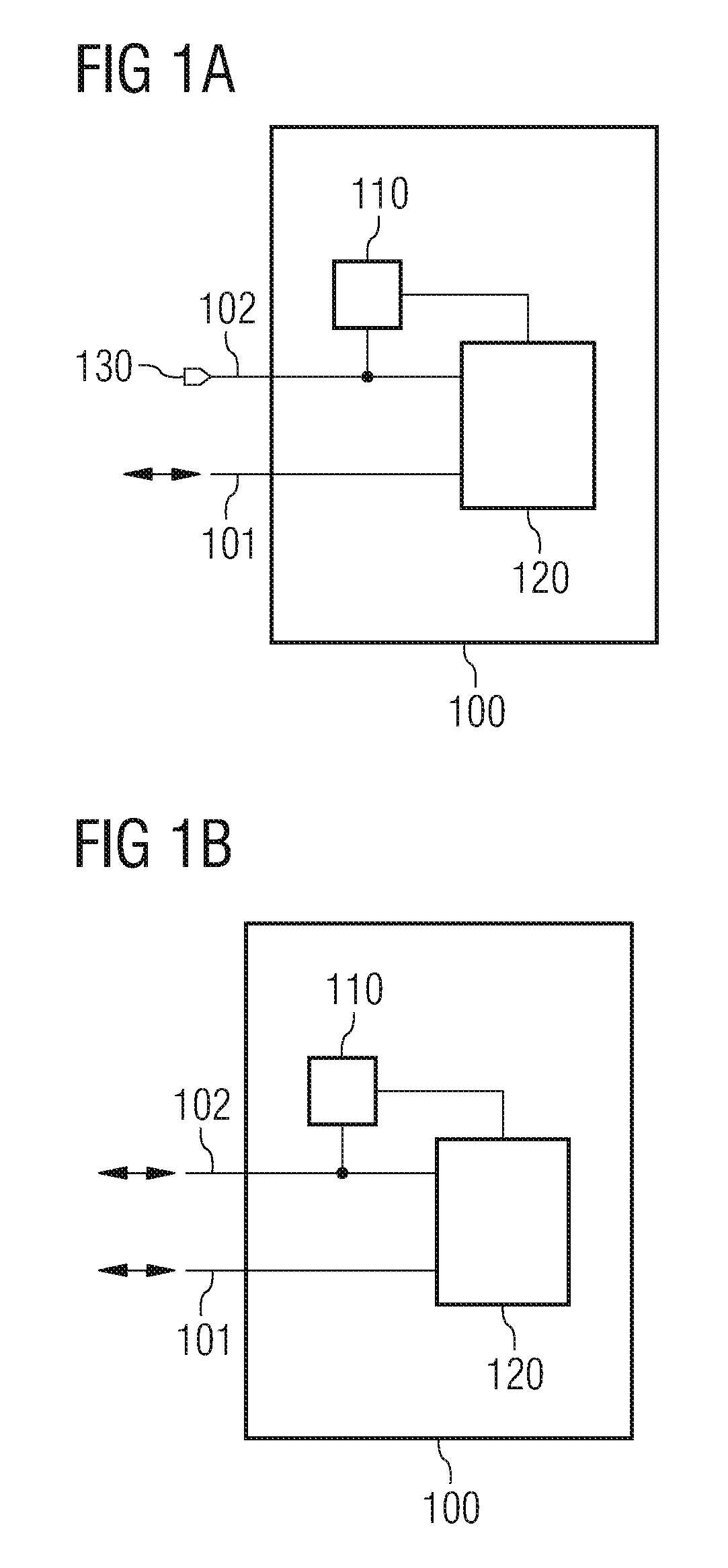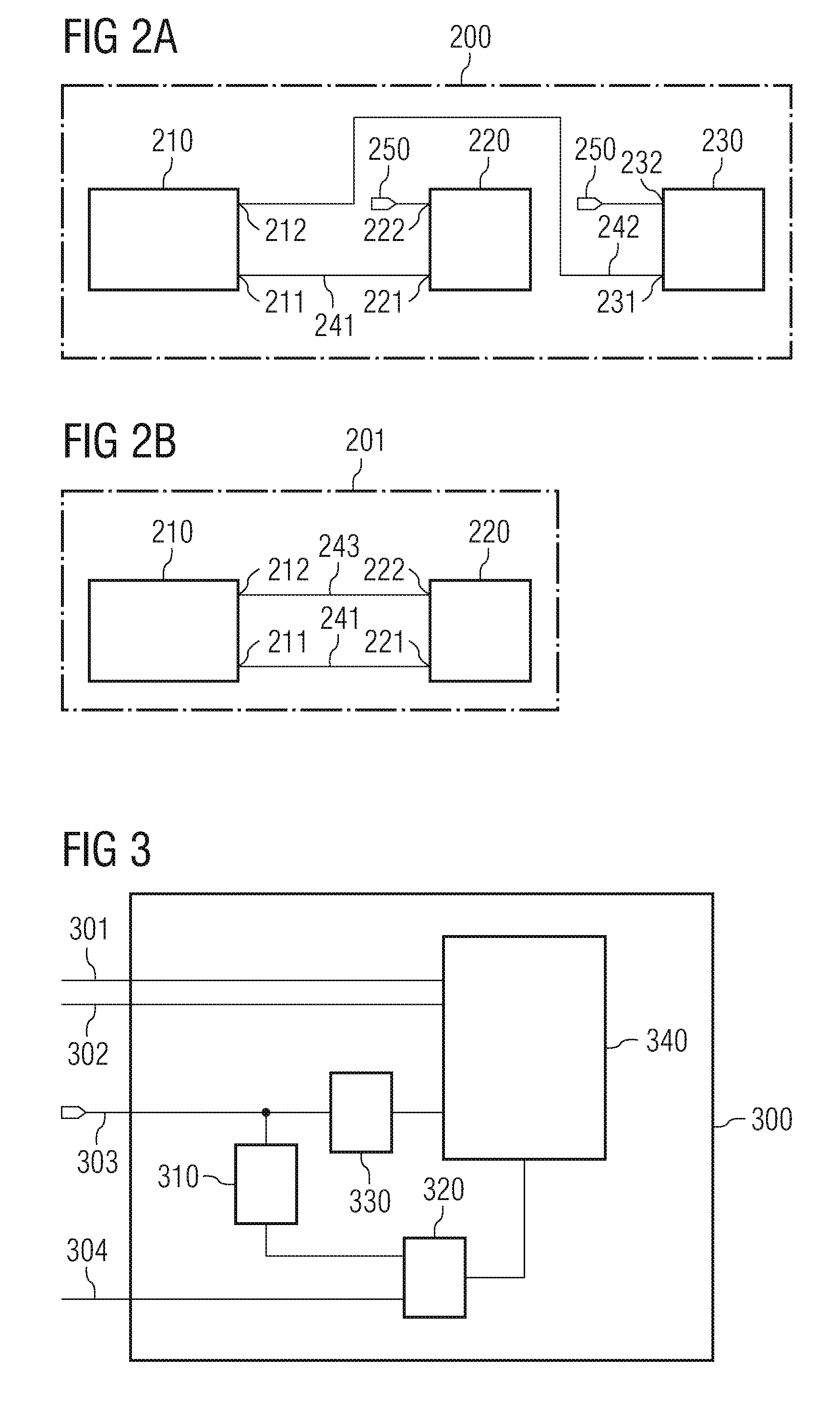Evaluation unit in an integrated circuit
a technology of integrated circuits and evaluation units, applied in the field of integrated circuits, can solve the problems of high manufacturing cost and process complexity, and achieve the effects of improving memory modules, improving computer performance, and improving memory devices
- Summary
- Abstract
- Description
- Claims
- Application Information
AI Technical Summary
Benefits of technology
Problems solved by technology
Method used
Image
Examples
first embodiment
[0023]FIG. 1A shows a schematic view of an integrated circuit 100 according to the present invention. The integrated circuit 100 comprises an evaluation unit 110 and a switching unit 120. The integrated circuit 100 further comprises a first terminal 101 and a second terminal 102.
[0024]The integrated circuit 100 exchanges signals via the first terminal 101 and the second terminal 102. The terminals 101, 102 may comprise a single signal line or a port with more than one signal line for receiving and / or transmitting signals. According to this embodiment of the present invention, the second terminal 102 of the integrated circuit 100 is coupled to a signal source, for example a voltage source 130 as shown in FIG. 1A. For example, upon initialization or power up, the evaluation unit 110 determines a voltage level being applied to the second terminal 102 by the voltage source 130. In case the determined voltage corresponds to a control voltage, the evaluation unit 110 instructs the switchi...
second embodiment
[0025]FIG. 1B shows a schematic view of the integrated circuit 100 according to the present invention. According to this embodiment, the integrated circuit 100, comprising the evaluation unit 110, the switching unit 120, the first terminal 101, and the second terminal 102, is supposed to exchange signals via both terminals 101, 102. In this case, the second terminal 102 may be coupled to other entities of a superordinate circuitry. However, it may be connected such that the evaluation unit 110 does not determine a voltage at the second terminal 102 that corresponds to said control voltage, as described in conjunction with FIG. 1A in which the second terminal 102 is coupled to the control voltage source 130. According to this embodiment, the evaluation unit 110 instructs the switching unit 120 such that both terminals 101, 102 are used for signal exchange.
third embodiment
[0026]FIG. 2A shows a schematic view of a first computer system 200 according to the present invention. The computer system 200 comprises a first device 210, a second device 220, and a third device 230. A first terminal 211 of the first device 210 is coupled to a first terminal 221 of the second device 220 via a first signal line 241. A second terminal 212 of the first device 210 is coupled to a first terminal 231 of the third device 230 via a second signal line 242. A second terminal 222 of the second device 220 and a second terminal 232 of the third device 230 are coupled to a voltage source 250.
[0027]According to this embodiment of the present invention, the first device 210 may exchange signals with the second device 220 and the third device 230 via the signal lines 241, 242. The devices 220, 230, being, for example, integrated circuits 100 as described in conjunction with FIG. 1A, only employ their first terminal 221, 231 respectively for signal exchange. The application of a c...
PUM
 Login to View More
Login to View More Abstract
Description
Claims
Application Information
 Login to View More
Login to View More - R&D
- Intellectual Property
- Life Sciences
- Materials
- Tech Scout
- Unparalleled Data Quality
- Higher Quality Content
- 60% Fewer Hallucinations
Browse by: Latest US Patents, China's latest patents, Technical Efficacy Thesaurus, Application Domain, Technology Topic, Popular Technical Reports.
© 2025 PatSnap. All rights reserved.Legal|Privacy policy|Modern Slavery Act Transparency Statement|Sitemap|About US| Contact US: help@patsnap.com



